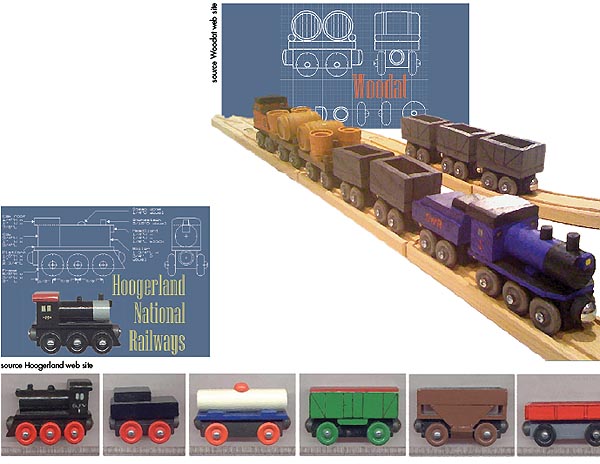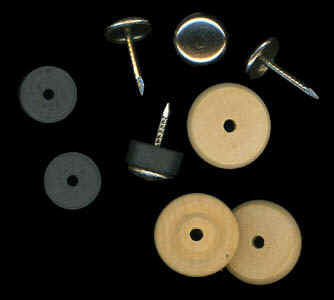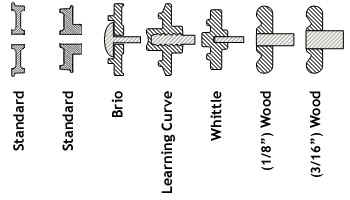 Undecorated railcars are a great resource. These have been packaged in small sets called ‘Paint and Play’ and marketed for kids to decorate. They were available in bulk through the Tomy Outlet Store – whether they will be available from Fisher-Price® is uncertain. You might also ‘recycle’ older train cars, putting new bodies onto the base or transferring the wheels to the new train car.
Undecorated railcars are a great resource. These have been packaged in small sets called ‘Paint and Play’ and marketed for kids to decorate. They were available in bulk through the Tomy Outlet Store – whether they will be available from Fisher-Price® is uncertain. You might also ‘recycle’ older train cars, putting new bodies onto the base or transferring the wheels to the new train car.
 If starting from scratch, take measurements from other railcars. Magnets need to be set at the right height and with the appropriate polarity. More information can be found at the following site,
If starting from scratch, take measurements from other railcars. Magnets need to be set at the right height and with the appropriate polarity. More information can be found at the following site,


 pw1.netcom.com/~thoog/hnr/hnr.html
pw1.netcom.com/~thoog/hnr/hnr.html





Custom Locomotives
 Parts are available for creating custom engines and cars. Shown are ceramic magnets, rounded couplers, and wooden wheels that can be found at Cherry Tree Toys and other sources. The wooden wheels have a 1/8” diameter hole and accommodate a dowel or screw for the axle.
Parts are available for creating custom engines and cars. Shown are ceramic magnets, rounded couplers, and wooden wheels that can be found at Cherry Tree Toys and other sources. The wooden wheels have a 1/8” diameter hole and accommodate a dowel or screw for the axle.
 I ‘child tested’ the wheels using a glued 1/8” birch dowel axle. Within a few minutes of casual twisting the dowel completely disintegrated and snapped in the middle. Using a carbon fiber graphite shaft and CA glue held up better, but the glue set up so quickly it was difficult to get the wheel balanced on the axle to prevent wobble.
I ‘child tested’ the wheels using a glued 1/8” birch dowel axle. Within a few minutes of casual twisting the dowel completely disintegrated and snapped in the middle. Using a carbon fiber graphite shaft and CA glue held up better, but the glue set up so quickly it was difficult to get the wheel balanced on the axle to prevent wobble.
 The wheel can be drilled to accept a larger 3/16” hard wood dowel. With twice the cross-sectional area, this could be a more rugged option. But a wood axle rolling against wood has a lot of friction and the wheels don’t spin as easily as desired. The nail through the magnet may also be long enough to wear against the axle. A plastic or metal sleeve could help to reduce friction and wear, but a larger axle also requires a deeper railcar undercarriage that tends to drag on the track over ramps and arch bridges.
The wheel can be drilled to accept a larger 3/16” hard wood dowel. With twice the cross-sectional area, this could be a more rugged option. But a wood axle rolling against wood has a lot of friction and the wheels don’t spin as easily as desired. The nail through the magnet may also be long enough to wear against the axle. A plastic or metal sleeve could help to reduce friction and wear, but a larger axle also requires a deeper railcar undercarriage that tends to drag on the track over ramps and arch bridges.




 Dowels, Spindles, drums, and similar items can be used to customize railcars - making loads for gondola and flatcars for example. Multiple sources exist for these, including:
Dowels, Spindles, drums, and similar items can be used to customize railcars - making loads for gondola and flatcars for example. Multiple sources exist for these, including:


 www.cherrytreetoys.com
www.cherrytreetoys.com


 www.craftparts.com
www.craftparts.com

Wheel Profile
 Shown are the cross-sections and axle configurations for standard model trains, three of the wood train manufacturers, and wood wheels with either a 1/8” or 3/16” wooden axle. The Brio® cars have an axle that captures the wheel. Thomas™, Whittle™, and others rely on an axle with knurling, barbs, or rings to secure the wheels.
Shown are the cross-sections and axle configurations for standard model trains, three of the wood train manufacturers, and wood wheels with either a 1/8” or 3/16” wooden axle. The Brio® cars have an axle that captures the wheel. Thomas™, Whittle™, and others rely on an axle with knurling, barbs, or rings to secure the wheels.

